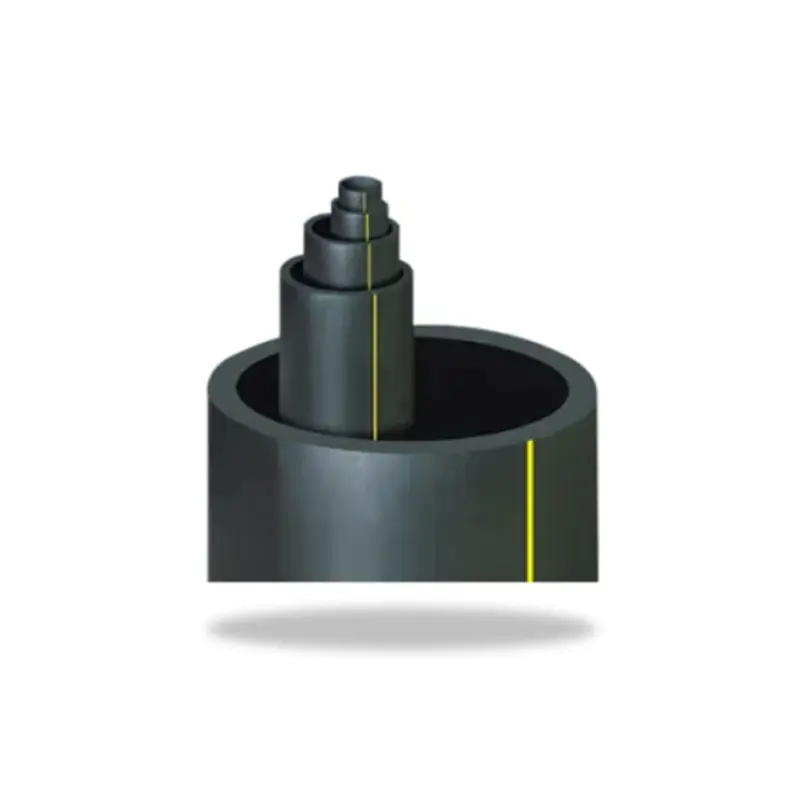HDPE Pipe For Gas have become a commonly used material in gas delivery systems due to their excellent physical properties and applicability. Compared with traditional metal pipes, HDPE pipes offer a range of significant conveniences during transportation, storage and installation. These advantages make them more attractive in a variety of environments and applications.
The weight of HDPE pipes is much lower than traditional metal pipes such as steel pipes and cast iron pipes, so they are lighter during transportation. For pipes of the same specifications, the weight of HDPE pipes is usually one-third or even less than that of metal pipes, which makes the handling process more labor-saving, especially in long-distance transportation or complex terrain transportation tasks, reducing transportation costs and labor costs. .
Small diameter HDPE pipes can usually be rolled into coils for easy transportation and storage. This curled form not only reduces the transportation space, but also reduces the volume of transportation and saves transportation costs. This is especially beneficial in some narrow environments or when transporting over long distances.
HDPE pipes can be transported by a variety of transportation methods such as trucks, trains, ships, etc., and due to the pressure resistance and weather resistance of the pipes, they are less likely to be damaged during transportation. For large-scale projects, the transportation fleet can carry a large number of HDPE pipes to ensure the construction progress of the project.
Compared with traditional metal pipes, HDPE pipes are smaller in size and require relatively less space for storage due to their lightweight and rollable properties. This saves warehouse space and makes inventory management more flexible and efficient.
HDPE pipes themselves have excellent corrosion resistance and are not prone to rust or corrosion, so no special anti-corrosion measures are required during storage. This is unlike metal pipes, which often require additional rust prevention treatment when stored.
HDPE pipes are not susceptible to temperature changes, humidity or UV rays during storage. Although prolonged exposure to sunlight can affect the UV resistance of the pipe's exterior, generally speaking, it still maintains stable physical properties. If long-term storage is required, pipes can be stacked indoors or in a shaded place to avoid excessive UV exposure.

The installation process of HDPE pipe is generally easier and faster than traditional metal pipe, especially in small and medium diameter pipe applications. The installation process mainly adopts hot melt welding, butt welding or electrofusion connection methods. These methods do not require the use of external joints or complex welding equipment. When installed, welded joints provide a better seal, reducing the risk of potential leaks.
HDPE pipe connection methods are flexible, and common connection methods include hot melt welding, electrofusion connection, butt welding, etc. These connection methods can be flexibly selected according to the actual conditions on site. Especially in complex installation environments, the connection method using HDPE pipes is often simpler and faster. In contrast, metal pipes usually require more complex welding and processing processes and require longer installation cycles.
When installing HDPE pipes, complex welding techniques and equipment are generally not required. The required equipment includes hot melt welding machines, electric welding equipment, etc. These equipment are relatively simple, the training time for operators is short, and the training cost and equipment investment of the construction team are low.
Because HDPE pipes have good flexibility and can adapt to a certain degree of bending, they can be laid and adjusted flexibly during the installation process, especially in places with complex terrain or limited space. For traditional rigid metal pipes, they have poor ability to bend or adapt to complex terrain and require special processing.
HDPE pipes have a certain degree of seismic resistance. In areas prone to earthquakes or places prone to geological movements, HDPE pipes perform more stably after installation. Traditional metal pipes are prone to damage or leakage due to earthquakes or geological changes. HDPE pipes can better cope with this situation due to their flexibility and ductility.
Once installed, HDPE pipes have strong corrosion resistance, aging resistance and sealing properties. They are usually not affected by the external environment (such as soil, chemicals) and have low maintenance costs. Traditional metal pipes may require regular inspection and maintenance during use, while HDPE pipes generally do not require frequent maintenance due to their material characteristics.
HDPE pipes have a long service life, usually more than 50 years (by design standards) and have low maintenance costs. Its corrosion resistance, wear resistance, and anti-aging properties eliminate the need for complex maintenance operations during long-term use of the pipeline, thereby saving a large amount of later maintenance costs.
These advantages make HDPE pipes increasingly popular as a cost-effective solution in gas transmission and other applications.

 简体中文
简体中文 English
English русский
русский Español
Español Français
Français عربى
عربى Português
Português












